Overview
The article primarily aims to identify essential land data aggregation tools that title research directors can leverage to enhance their workflows. Accurate title research is crucial, yet professionals often encounter significant challenges in data collection and analysis. This article highlights various tools, including:
- Parse AI
- DataChannel
- Tableau
emphasizing their capabilities in automating data collection, improving accuracy, and facilitating informed decision-making. Consequently, these tools demonstrate a substantial impact on the efficiency and effectiveness of title research processes. By integrating these solutions, title research directors can streamline their workflows and achieve greater operational success.
Introduction
In the realm of title research, the efficiency and accuracy of data handling can significantly influence the success of a project. As the demand for precise information escalates, professionals in the real estate sector are increasingly turning to advanced land data aggregation tools to streamline their workflows. This article explores ten essential tools that not only automate title research but also enhance decision-making processes, offering a competitive edge in a rapidly evolving landscape. However, with a myriad of options available, how can one discern which tools will genuinely transform their research practices and yield the most substantial benefits?
Parse AI: Advanced Machine Learning for Title Research Automation
Parse AI employs advanced machine learning algorithms alongside sophisticated optical character recognition (OCR) to streamline the extraction of vital information from document titles. This innovative technology significantly diminishes the time and effort traditionally required for document investigation, allowing professionals to redirect their focus towards more strategic initiatives.
By adeptly processing substantial volumes of document titles, Parse AI empowers researchers to produce accurate abstracts and reports with impressive speed, thereby markedly enhancing workflow productivity within the real estate sector.
Industry reports indicate that the global OCR systems market was valued at approximately USD 8.1 billion in 2023, highlighting the escalating significance of this technology. Real estate experts have noted that the integration of OCR technology not only enhances precision but also reduces operational costs, making it an indispensable tool in modern document examination.
As one examination manager stated, 'The adoption of OCR has revolutionized our workflow, enabling us to concentrate on strategic decision-making instead of becoming overwhelmed by entry tasks.'
Furthermore, success stories from companies implementing Parse AI reveal a 30% reduction in processing time for document titles, underscoring the tangible benefits of this cutting-edge technology.
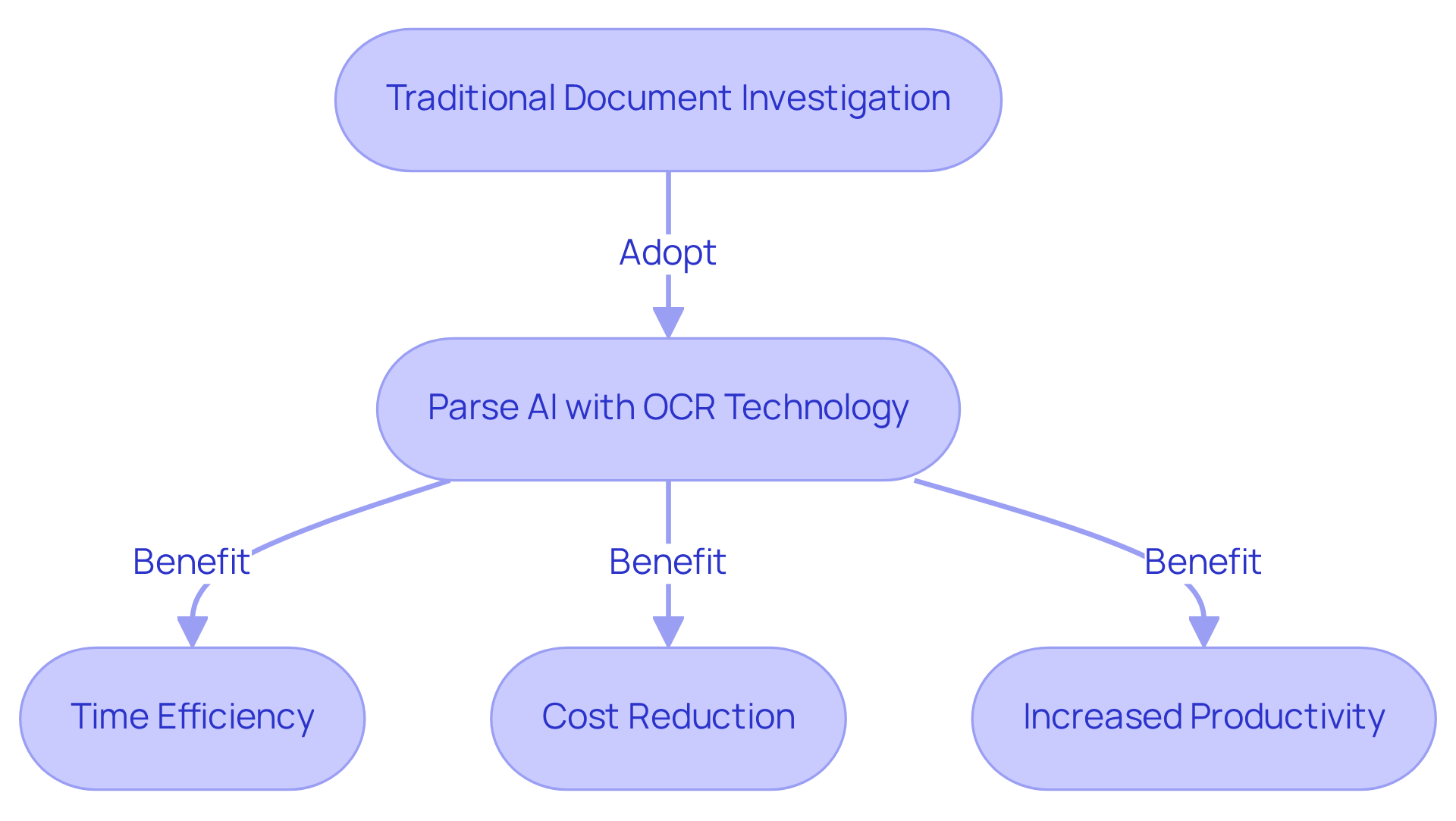
DataChannel: Integrated ETL Solutions for Efficient Data Aggregation
DataChannel serves as a robust platform for integrated ETL solutions, empowering project leads to efficiently gather information from diverse sources. Its intuitive interface facilitates seamless transformation and loading of data into centralized repositories, guaranteeing that title researchers have access to accurate and up-to-date information. Furthermore, by automating these processes, DataChannel significantly reduces manual data handling, thereby minimizing the risk of errors and enhancing overall research efficiency.
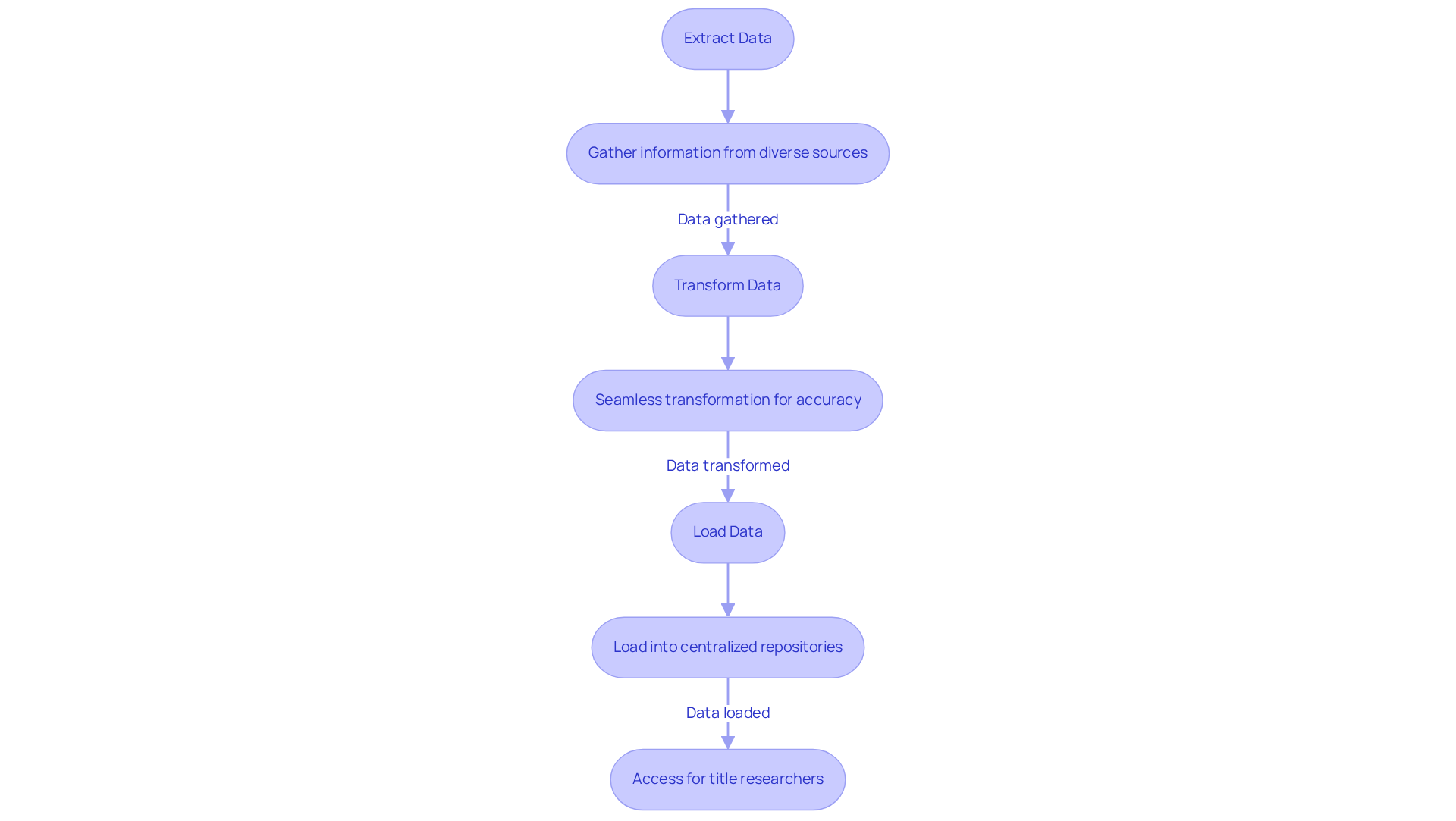
Hevo Data: Automated Data Aggregation for Accurate Title Research
Hevo Data emerges as a powerful automated land data aggregation tool that effectively streamlines the collection and integration of data from various sources. For project supervisors, this innovation significantly reduces the time spent on manual data entry, allowing for a greater emphasis on analysis and strategic decision-making. The platform's capability for real-time information synchronization ensures that researchers consistently operate with the most up-to-date details, a critical factor in enhancing the accuracy of reports and abstracts.
Industry leaders recognize that real-time information synchronization not only boosts operational efficiency but also fosters informed decision-making, ultimately leading to more reliable outcomes in investigations. As Geoffrey Moore asserts, "Data is absolutely crucial to making smart business decisions," highlighting the necessity of adopting technologies like Hevo Data.
Furthermore, with over 90% of large enterprises investing in land data aggregation tools and AI projects, the importance of such tools in research cannot be overstated.
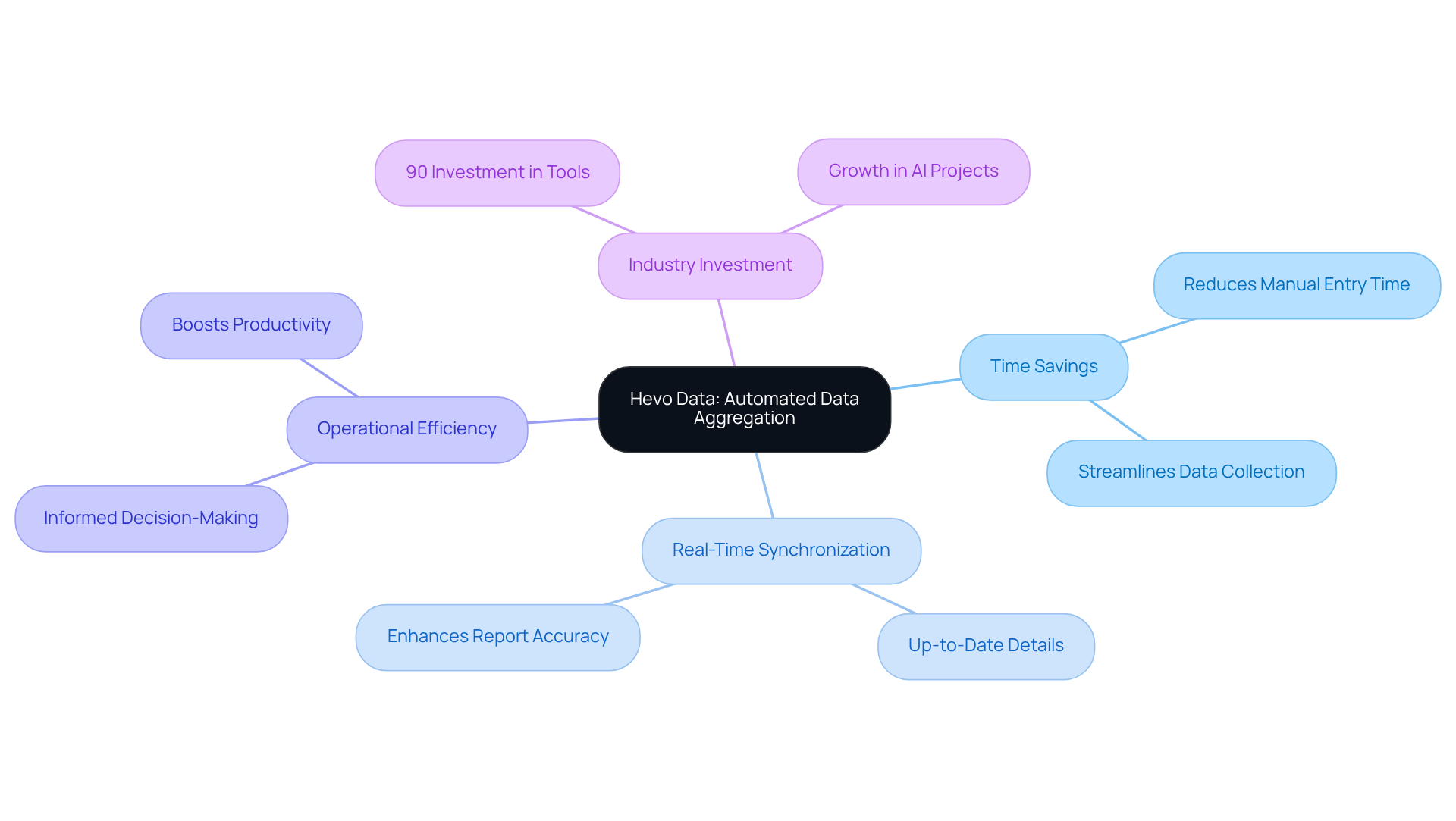
LexisNexis: Comprehensive Data Aggregation for Legal Compliance
LexisNexis serves as a pivotal resource for researchers, providing comprehensive data aggregation services that are essential for maintaining legal compliance. By utilizing a vast array of public records, legal databases, and other authoritative sources, LexisNexis equips property researchers with the reliable information necessary to confirm ownership and adhere to legal standards. This tool is indispensable for individuals managing documentation, who must adeptly navigate intricate legal environments while ensuring the accuracy and compliance of their reports. The integration of such robust information sources not only streamlines the investigative process but also enhances the overall integrity of documentation examination, underscoring the importance of thorough legal adherence within the industry.
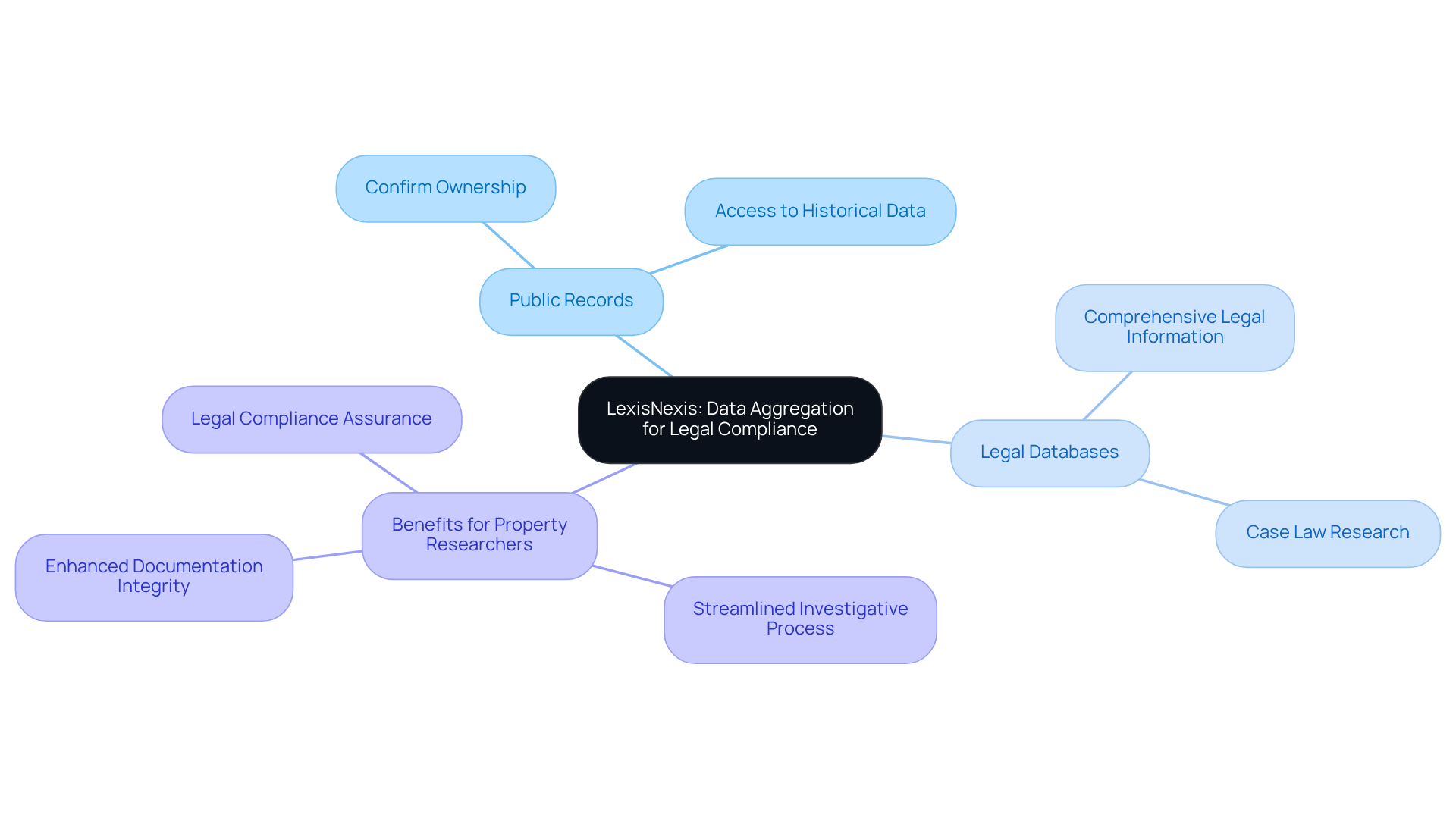
Tableau: Data Visualization for Enhanced Land Data Analysis
Tableau stands out as a leading visualization tool, empowering project directors to craft interactive and insightful visual representations using land data aggregation tools. By transforming raw data into visually engaging dashboards, Tableau enables researchers to uncover trends, patterns, and anomalies in property ownership details. This capability not only enhances analytical precision but also supports informed decision-making, facilitating clearer communication of findings to stakeholders.
The impact of information visualization in research is underscored by the reality that organizations leveraging such tools can significantly improve their decision-making processes. A compelling case study exemplifies this, revealing how a team utilized Tableau to optimize their analysis, resulting in a 30% reduction in the time needed to generate reports.
Furthermore, industry leaders have noted that well-organized dashboards and land data aggregation tools can convert complex datasets into actionable insights, thereby simplifying the navigation of land records for title research managers. As one leader remarked, 'The transparency offered by our Tableau dashboards has transformed our method of analysis, allowing us to make faster, more knowledgeable decisions.'
Additionally, with companies potentially losing an estimated $5.2 million in revenue due to unutilized information, the importance of effective visualization becomes even more apparent. The anticipated 36% increase in the demand for information specialists further highlights the necessity for title research directors to adopt tools like Tableau to remain competitive.
As Hilary Mason aptly stated, 'The information alone cannot provide you with all the answers you're seeking,' emphasizing the critical need for context and storytelling in visual representation. However, it is crucial to be cognizant of potential pitfalls—such as improper scaling or misrepresenting values—that can distort conclusions and undermine the credibility of information. This illustrates the profound impact that successful information visualization can have on enhancing outcomes in examination.
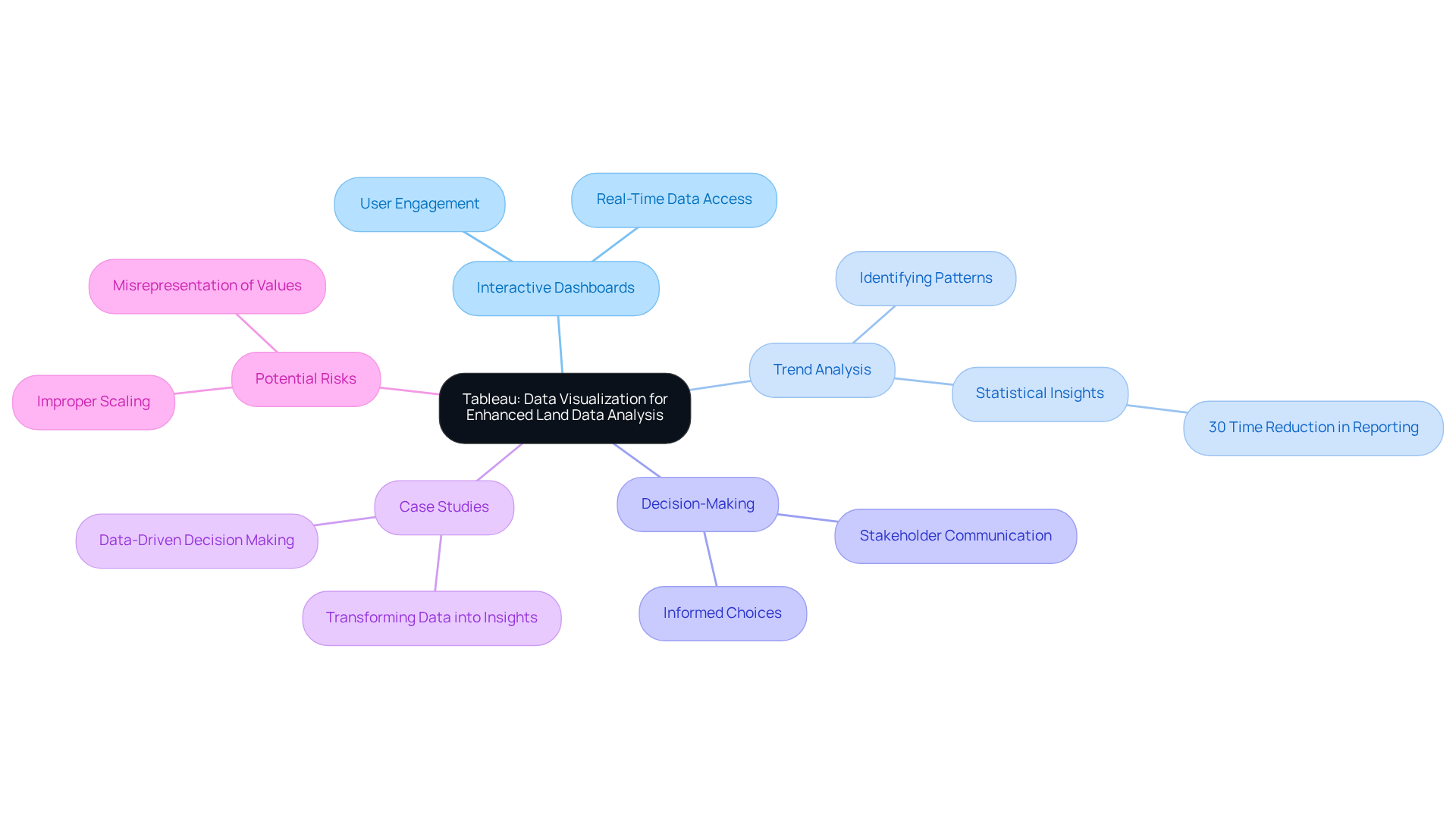
Microsoft Power BI: Reporting and Data Aggregation for Informed Decision-Making
Microsoft Power BI stands out as a formidable business intelligence tool, empowering project directors to seamlessly integrate data from diverse sources and produce insightful reports. Its intuitive interface facilitates the creation of tailored dashboards that vividly illustrate key metrics pertinent to property ownership and title research. This capability not only streamlines access to essential information but also accelerates and enhances the accuracy of decision-making in real estate transactions.
For example, organizations utilizing Power BI have reported marked improvements in operational efficiency, with some case studies revealing a reduction in report generation time by as much as 50%. Furthermore, industry experts emphasize that effective reporting is crucial for informed decision-making, enabling stakeholders to analyze trends and make strategic choices based on real-time data.
As Richard Hellinga from Turntide Technologies notes, "The increasing demand to lower energy expenses and offer clear sustainability information signifies we’ve experienced a notable rise in adoption over the last two years as companies seek persuasive investment business cases."
The integration of land data aggregation tools, including Power BI, is transforming property examination processes, allowing for more agile responses to market fluctuations and ultimately leading to enhanced outcomes in real estate transactions.
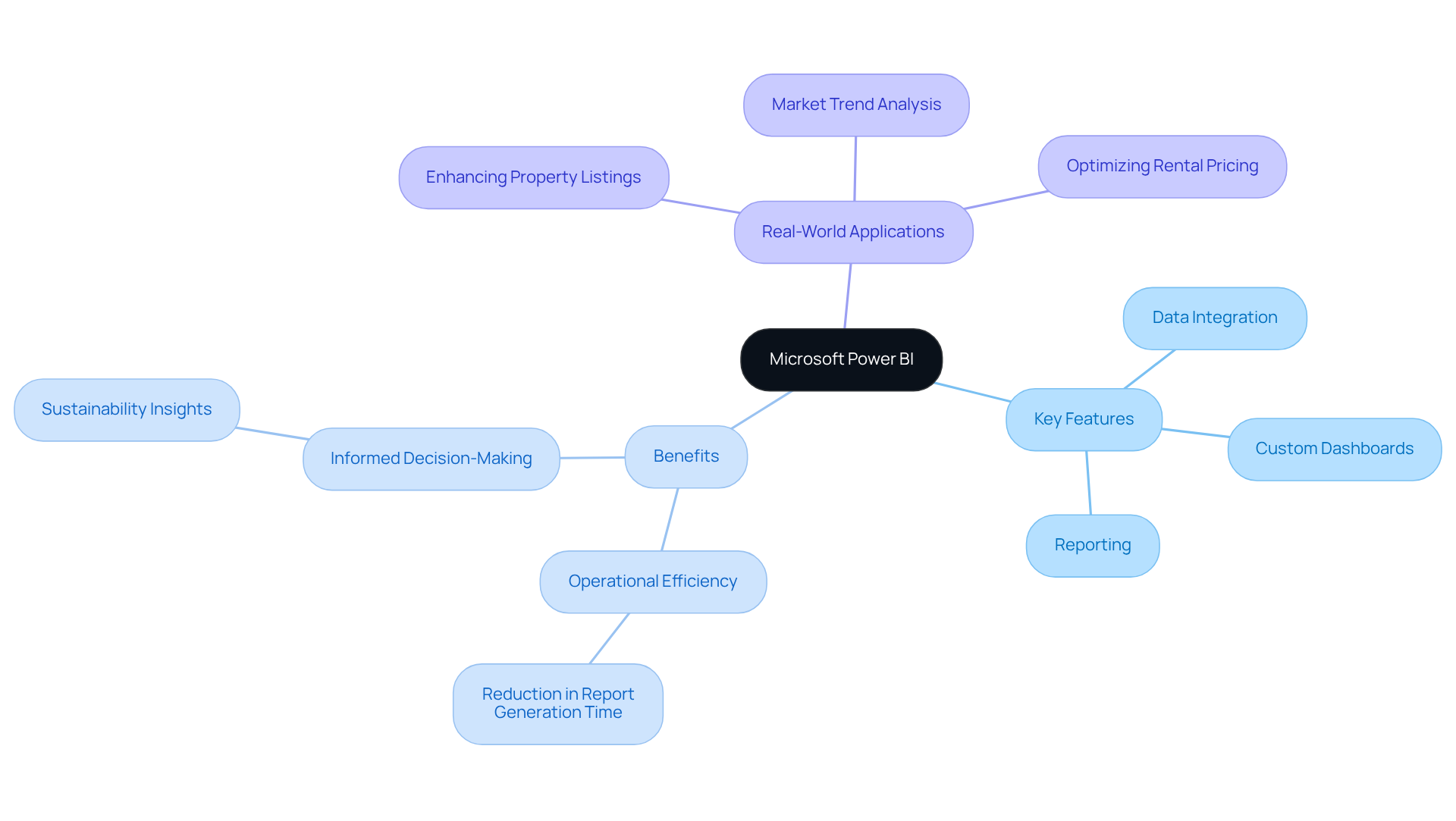
Qlik Sense: User-Friendly Data Aggregation and Analysis Platform
Qlik Sense stands out as an accessible platform for land data aggregation tools, designed to empower project leaders in their quest for effective information exploration and visualization. Its intuitive interface enables users to create interactive reports and dashboards without the need for extensive technical expertise. This accessibility significantly enhances investigators' ability to swiftly examine property information, uncover valuable insights, and make informed, evidence-based decisions that improve study outcomes.
Success stories from various investigation teams illustrate how Qlik Sense has transformed their workflows, allowing them to focus more on strategic analysis rather than being bogged down by complex data handling. As one project supervision director noted, the platform's user-friendliness has been pivotal in enhancing productivity, enabling teams to deliver results more quickly and with greater accuracy.
The impact of land data aggregation tools as user-friendly resources on document investigation productivity cannot be overstated; they foster a more efficient analysis approach, ultimately leading to improved decision-making and higher quality studies.
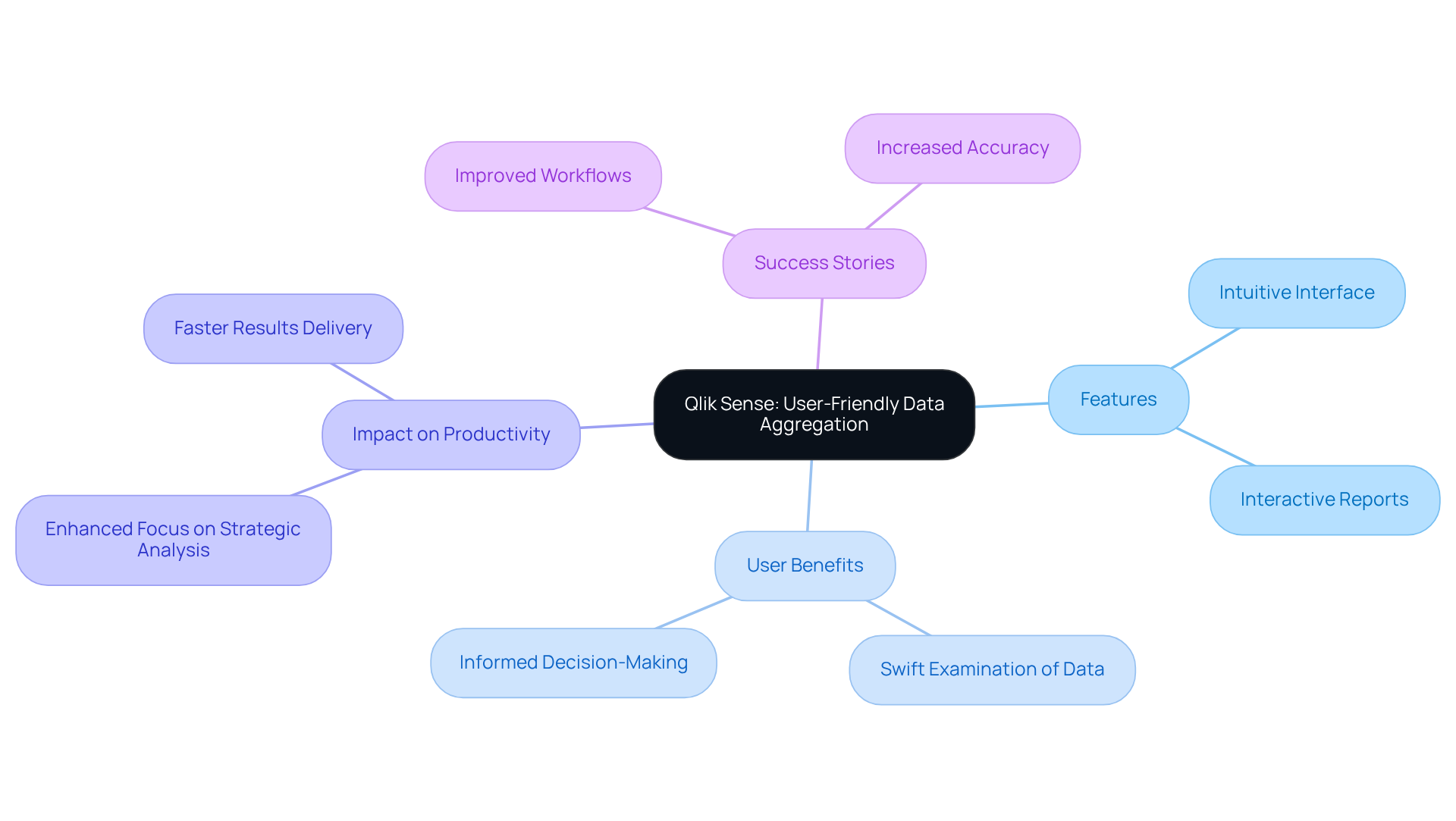
Domo: Cloud-Based Data Integration for Title Research Efficiency
Domo serves as a pivotal cloud-based information integration platform, streamlining examination by consolidating diverse sources into a coherent, unified perspective. This integration not only empowers researchers to access real-time data but also fosters seamless collaboration across teams. Furthermore, with its robust analytical capabilities, Domo enables users to rapidly obtain insights, significantly enhancing the effectiveness of the examination process and facilitating prompt decision-making. Organizations leveraging Domo have reported substantial improvements in their study workflows, underscoring the platform's efficiency in optimizing project inquiry operations.
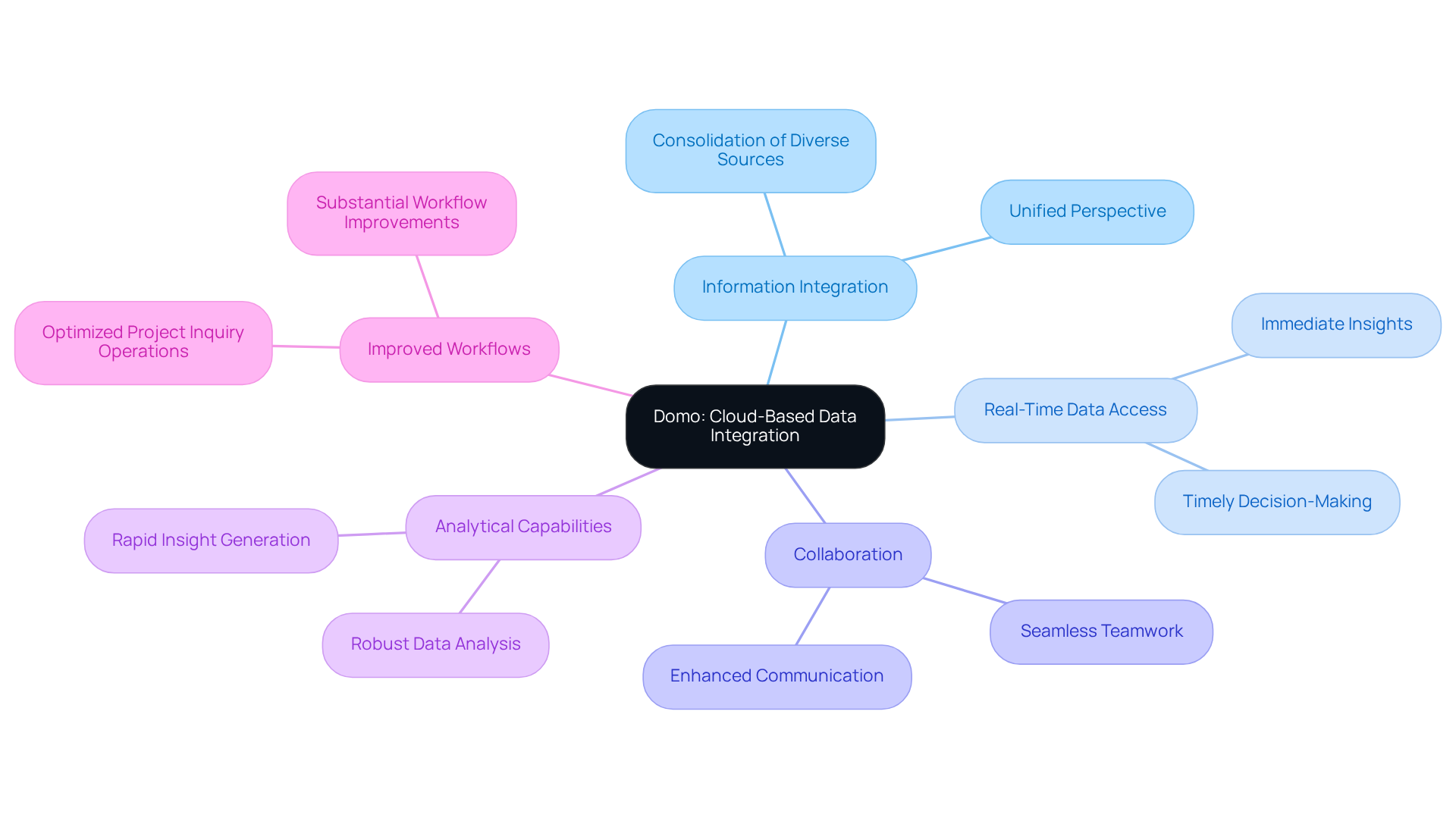
Alteryx: Advanced Analytics for Enhanced Data Aggregation
Alteryx stands as a sophisticated analytics platform, empowering directors to execute intricate compilations and evaluations. Its intuitive interface allows users to use land data aggregation tools to amalgamate information from diverse sources, apply advanced analytical techniques, and generate actionable insights. This capability is particularly advantageous for document investigators tasked with examining extensive datasets and uncovering patterns that inform their analysis and reporting.
For instance, a notable case study underscored how researchers leveraged Alteryx to synthesize unstructured information from various documents, yielding a comprehensive understanding of property histories. This integration not only heightened the accuracy of their reports but also expedited the research process, thereby facilitating quicker decision-making.
Moreover, industry leaders have recognized that using land data aggregation tools to consolidate various information sources fosters deeper insights, thereby enhancing the overall quality of their evaluations. As one director articulated, 'Combining information sources has transformed our approach to examining titles, enabling us to uncover insights that were previously obscured.'
The impact of advanced analytics through platforms like Alteryx is evident in the increased efficiency and effectiveness of property investigations, ultimately leading to more informed decisions within the real estate sector. Industry projections anticipate that the advanced analytics market will experience a CAGR of 22.0% from 2025 to 2032, underscoring the growing significance of such tools. Furthermore, with an expected 35% growth rate for scientist roles from 2022 to 2032, the demand for skilled professionals in advanced analytics is on the rise, further highlighting the critical role of platforms like Alteryx in navigating these challenges.
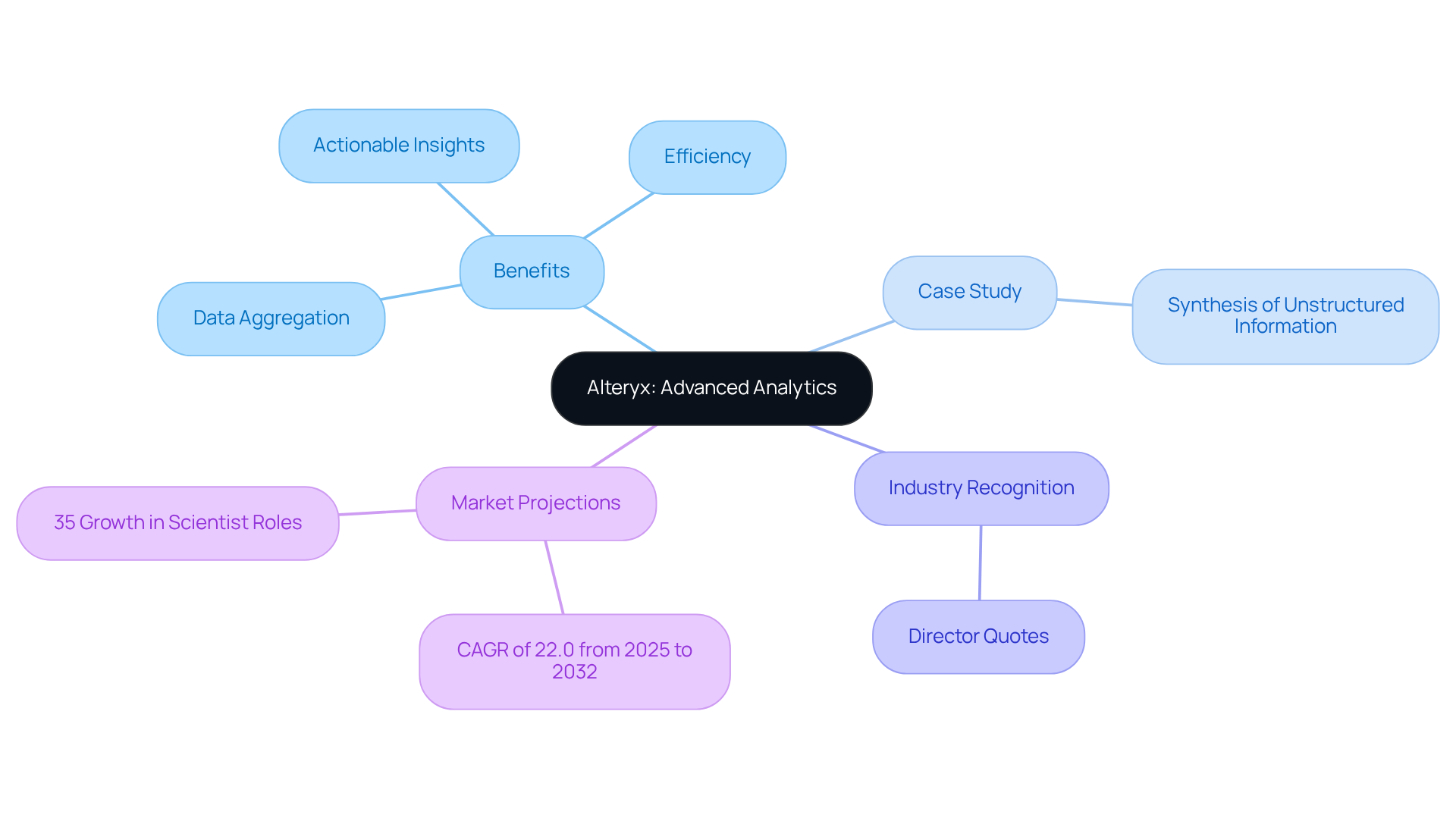
Google Data Studio: Free Tool for Visualizing Aggregated Land Data
Google Data Studio emerges as a powerful, free tool that empowers project directors to create interactive and visually engaging reports from land data aggregation tools. Its intuitive drag-and-drop interface simplifies the visualization of complex datasets, enabling researchers to present their findings with clarity and impact.
By leveraging Google Data Studio, researchers can significantly enhance their reporting capabilities while avoiding additional expenses, making it an ideal choice for budget-conscious teams. Success stories abound, with professionals highlighting that such cost-effective solutions not only streamline workflows but also elevate the overall quality of their reports.
As one expert in the field remarked, 'Using free tools such as Google Data Studio has transformed our reporting process, allowing us to focus more on analysis rather than formatting.' This observation reflects a broader trend where budget-friendly reporting tools are increasingly acknowledged for their role in enhancing efficiency and effectiveness in title research.
Furthermore, with many libraries facing budget cuts, the necessity for accessible and effective tools like Google Data Studio has never been more critical.
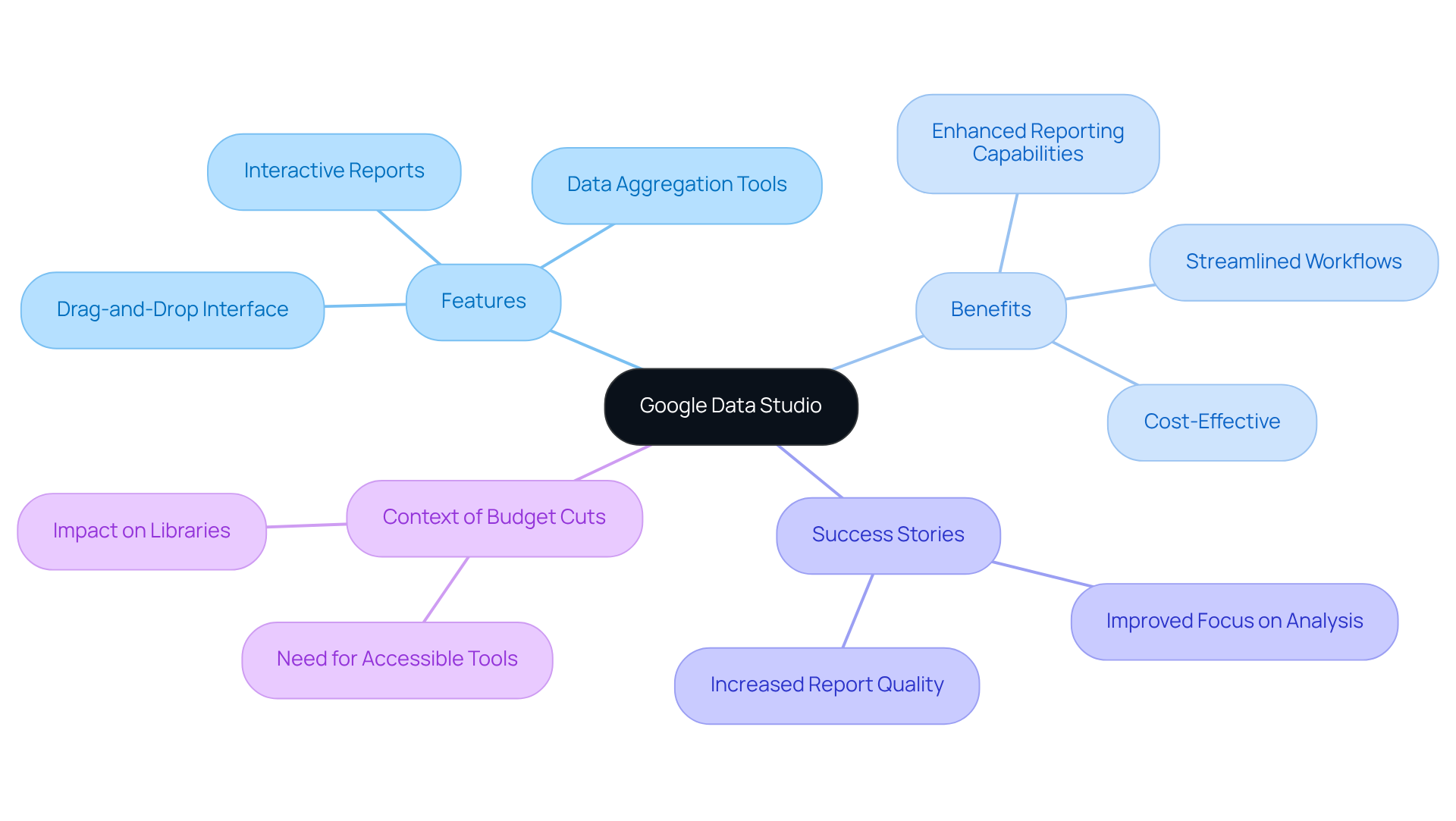
Conclusion
The exploration of essential land data aggregation tools unveils a transformative landscape for title research directors, underscoring the critical need for integrating advanced technologies to streamline workflows and enhance decision-making. By leveraging innovative platforms such as Parse AI, DataChannel, and Hevo Data, professionals can automate tedious tasks, access real-time information, and concentrate on strategic analysis, ultimately driving efficiency and accuracy in their operations.
Key insights from this exploration emphasize the importance of utilizing tools that not only simplify data aggregation but also strengthen legal compliance and reporting capabilities. For instance, LexisNexis stands out for its comprehensive data resources, while Tableau and Microsoft Power BI facilitate effective data visualization, rendering complex datasets more manageable and actionable. Furthermore, user-friendly platforms like Qlik Sense and Domo promote collaboration and rapid insights, further enhancing the research process.
As the demand for skilled professionals in advanced analytics continues to escalate, embracing these land data aggregation tools is essential for title research directors seeking to remain competitive in an evolving industry. The integration of such technologies not only streamlines operations but also empowers teams to make informed decisions based on accurate and timely data. Consequently, adopting these tools can significantly improve research outcomes, ensuring that organizations are well-equipped to navigate the complexities of title research and property transactions.
Frequently Asked Questions
What is Parse AI and how does it assist in title research automation?
Parse AI employs advanced machine learning algorithms and optical character recognition (OCR) to streamline the extraction of vital information from document titles, significantly reducing the time and effort required for document investigation.
How does Parse AI impact workflow productivity in the real estate sector?
By processing large volumes of document titles quickly, Parse AI enables researchers to produce accurate abstracts and reports faster, thereby enhancing workflow productivity within the real estate sector.
What is the current market value of OCR systems, and why is it significant?
The global OCR systems market was valued at approximately USD 8.1 billion in 2023, indicating the growing importance of this technology in enhancing precision and reducing operational costs in document examination.
What benefits have companies experienced by implementing Parse AI?
Companies using Parse AI have reported a 30% reduction in processing time for document titles, showcasing the tangible benefits of this technology.
What role does DataChannel play in data aggregation for title researchers?
DataChannel provides integrated ETL solutions that allow project leads to efficiently gather, transform, and load data from various sources into centralized repositories, ensuring access to accurate and up-to-date information.
How does DataChannel enhance research efficiency?
By automating data handling processes, DataChannel minimizes the risk of errors and reduces the amount of manual data handling, thereby enhancing overall research efficiency.
What is Hevo Data and how does it benefit title research?
Hevo Data is an automated land data aggregation tool that streamlines the collection and integration of data from various sources, significantly reducing the time spent on manual data entry and allowing for a greater focus on analysis and strategic decision-making.
Why is real-time information synchronization important in research?
Real-time information synchronization ensures that researchers operate with the most up-to-date details, which is crucial for enhancing the accuracy of reports and abstracts, leading to more reliable outcomes in investigations.
What trend is seen among large enterprises regarding data aggregation tools?
Over 90% of large enterprises are investing in land data aggregation tools and AI projects, highlighting the increasing importance of these technologies in research.




